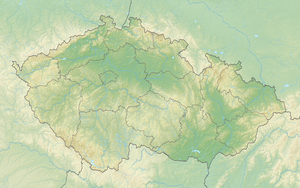Studenec (mountain)
| Studenec | ||
|---|---|---|
|
The Kaltenberg summit in 2010 |
||
| height | 736.5 m nm | |
| location | Czech Republic | |
| Mountains | Lusatian Mountains | |
| Coordinates | 50 ° 49'55 " N , 14 ° 27'19" E | |
|
|
||
| Type | Kegelberg | |
| rock | basalt | |
Studenec (German Kaltenberg ) is a prominent mountain in the Lusatian Mountains in the Czech Republic .

Origin of the name
It got its originally German name Kaltenberg from an exceptionally cold spring on the northeast slope. The Czech name Studenec is a translation of the German name.
Location and surroundings
The Studenec is located about four kilometers northeast of Česká Kamenice ( Böhmisch Kamnitz ) in the transition area between the Lusatian Mountains and Bohemian Switzerland . The small villages Líska ( Hasel ), Lipnice ( Limpach ) and Studený ( Kaltenbach ) are located directly at the foot of the mountain . Neighboring mountains are the Zlatý vrch ( Goldberg ) and the Chřibský vrch ( Himpelberg ).
geology
The summit of Studenec consists of a tertiary basalt . At the foot of the mountain there are Cretaceous sandstones , as they are particularly characteristic of the neighboring Elbe Sandstone Mountains .
As a special feature, round basalt rocks, so-called volcanic bombs, are found on the eastern mountain slope .
history
In the 19th century, the striking summit with its wide panoramic view was used by geodesists and cartographers to survey the country of Bohemia . A memorial stone with the inscription MONUMENTUM ASTRONOMICO-GEOMETRICUM on the summit reminds of this .
The area around the Kaltenberg was owned by the von Kinsky princes . Prince Ferdinand had a wooden observation tower built on the Kaltenberg in 1854 , which according to tradition is said to have been the second oldest observation tower in Bohemia. But that is doubted today. The scaffolding had to be demolished in 1865 because it was dilapidated. At the suggestion of the Mountain Association for Bohemian Switzerland, a new observation tower was built at the same location, which was inaugurated on July 18, 1888. This time the decision was made to use an iron construction, which was carried out by the Prague mechanical engineering company. The tower was 17 meters high with the base and offered space for 25 people on the upper viewing platform, to which 92 steps led.
Since more than 5,000 people visited the Kaltenberg in the first year of the new tower's existence, Prince von Kinsky had a wooden accommodation house built on the summit, in which the visitors were looked after in the summer and, if necessary, could stay overnight.
After the Second World War, the tower and Kinsky-Baude fell into disrepair. The latter burned down in the 1950s. The tower remained unprotected and exposed to all adverse weather conditions, so that numerous steps and the viewing platform were almost completely broken out.
It was not until the 1990s that first efforts were made to repair the tower. The Czech Tourist Club (KČT), as the owner at the time, was unable to find the necessary financial means for a renovation. Given the unique construction succeeded at least the KCT, the tower on 21 March 1997 under monument protection to be set.
In October 2007 the tower was dismantled into three parts and recovered by helicopter. The structure was repaired on a farm in Lipnice with the help of state funding and private donations. The renewed tower was brought back to Studenec on March 14, 2009. The opening took place on June 21, 2009. The leaf-free season is particularly suitable for an ascent, as the tower does not tower over all the trees.
natural reserve
Since 1930 for the first time and since 1965 after another designation, the entire area of 113 hectares around the Kaltenberg has been protected as the Studený vrch nature reserve .
Near-natural forests have been preserved all around the mountain, above all beech forests with characteristic plant species such as woodruff ( Galium odoratum ), single-flowered pearl grass , mountain speedwell ( Veronica montana ), perennial whelkweed , white tooth root , onion tooth root ( Cardamine bulbífera ), perennial Silver leaf ( Lunaria rediviva ) and cinquefoil .
On the slopes there are some block fields where you can occasionally see chamois that were released here in 1907.





